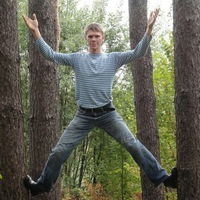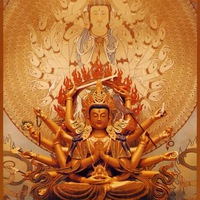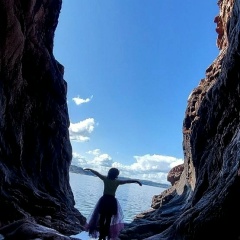Вот у индусов есть Мандукья Упанишада.
http://www.theosophy.ru/lib/upan-man.htm
Это Упанишада всего в 11 строчек, которую, как считается, человек должен посмотреть первой, и если он не понял её, тогда он отправляется читать остальные Упанишады, а если он и там затупил, то он отправляется читать Веды, и так далее.
Так вот, там 11 строчек всего, они про Аум.
Про то, что Атма(Самость, Абсолют) стоит на четырех стопах:
Первая - проявленный бодрствующий мир снаружи, звук "А", это сфера чувств.
Вторая - непроявленный ментальный мир внутри, он же сновидение, звук "У", это сфера ума.
Третья - это глубокий сон или же чистое сознание, которое не переживает ничего, это праджня, звук "М". Это же причинное тело, это же бытие, это же знание "я есть", это же связующее звено между бодрствованием и сновидением. Когда одно состояние заканчивается, но другое еще не началось, они оба сворачиваются в праджне. Имеет место своеобразный маятник между бодрствованием и сном. И основа обоих, точка баланса этого маятника - это "я есть".
Но четвертая стопа - турия - это сама пауза после того как "М" дозвучит, непроявленная, и она знает и составляет все три прочие проявленные ступени, но она максимально утончённая, и из грубых состояний её приметить нельзя. Тем не менее, это связующая непроявленная основа всех трёх состояний. Это то, почему мы сами присутствуем во всех возможных состояниях (бытия или небытия), и во всех возможных телах, хотя наши тела и ум присутствуют не всегда.
Так вот, к чему это всё. К тому, что осилив информацию лишь этой Упанишады и выбросив всё остальное, можно чётко различить границы состояний:
1) Всё "внешнее" и проявленное, то есть всё проявленное по ту сторону чувств - относится только к ограниченному состоянию бодрствования,
2) Всё "внутреннее" как мир идей, эмоций и концепций - остаётся в пределах этой "внутренней" сферы,
3) Ничто и никогда из одного состояния не может перейти в другое, буквально всё их содержимое, включая тело и ум, полностью уничтожаются на границе перехода между состояниями.
Бодрствующее физическое тело всегда остаётся в бодрствовании, а сновидящее ментальное тело - в сновидении.
Но самое интересное даже не это, а то, что мы Сами, очевидно, присутствуем во всех своих состояниях и во всех своих телах. Таким образом, можно судить о нашей природе и независимости от всех этих состояний, ВКЛЮЧАЯ само наше бытие, чувство "я есть", которое рождает эту череду бодрствования и сна и выступает как связующая их точка. Если ясно, что мы Сами сохраняемся при переходе, в котором без остатка уничтожаются и забываются все наши тела, то как можно продолжать соотносить Себя с бодрствующим физическим телом или концептуальным ментальным телом, или же каким-нибудь ещё выдуманным астральным телом, без разницы?
И это финал. Всё прочее, что может войти в дискуссию с этого момента, будет неизменно относиться либо к "внутреннему", либо "внешнему" мирам, но выяснено, что мы Сами не там и не там, и вообще там никогда не были. Разве мы внутри или снаружи себя? Что за фокус-покус?
Всё, что можно рассмотреть с этого момента, будет либо умствованием "внутри", либо чувствованием "снаружи", но и то, и другое - не про нас вовсе, мы не присутствуем ни снаружи себя, ни внутри себя. Вот она чистота и бессмертие, нечего добавить и ничего не отнять.
То есть наступает такой момент, когда что бы кто ни сказал, на что бы ни указал - это будет очерчено в мире чувств (бодрствовании) или в ментальном мире (уме), то есть будет отклонением из состояния прямого знания Себя. Это становится очевидно. Куда дальше-то шагать теперь? Прямое знание "Я Есть"- это финальная остановка. Откуда мы смотрим на своё "Я Есть", если не из Себя Самого? Ни формы, ни имени, только бескрайность Себя.
Вот, допустим, некто заявляет "Я Есть Всё", "Я Есть Парабрахман" и тп - это всё очень круто и духовно и всё такое, но разве это не в ментальной внутренней сфере сказано? Всё, что "внутри" и "снаружи" - это результат этого качения маятника состояний вокруг центрального "я есть", и всё это свернётся рано или поздно обратно в "я", и уйдёт полностью без остатка. Нельзя серьёзно полагаться на такие изречения и ставить свой штаб в духовных концепциях, потому как они уйдут обязательно, все эти высокие духовные состояния принадлежат времени и уйдут.
Это так же нереально, как и всё остальное, чего коснулось бытие.
Это всё сфера времени, у всего этого уже есть неизбежный конец.
Однако эта центральная точка "Я Есть", вокруг которой всё вертится, - это дверь в наш Абсолют - она ни снаружи, ни внутри. О бытии нельзя сказать, что оно снаружи или внутри, поскольку оно раньше самого этого разделения. И это ближе к нам, чем что-либо еще из нашего опыта. Хотя мы уже по внутреннюю сторону этой двери, но всё же только она достойна внимания, поскольку всё остальное полагается на это бытие чтобы быть. Уделяя ему внимание, всякое очищение происходит автоматически, и настоящая позиция - Абсолют - также автоматически проявляется.
http://www.theosophy.ru/lib/upan-man.htm
Это Упанишада всего в 11 строчек, которую, как считается, человек должен посмотреть первой, и если он не понял её, тогда он отправляется читать остальные Упанишады, а если он и там затупил, то он отправляется читать Веды, и так далее.
Так вот, там 11 строчек всего, они про Аум.
Про то, что Атма(Самость, Абсолют) стоит на четырех стопах:
Первая - проявленный бодрствующий мир снаружи, звук "А", это сфера чувств.
Вторая - непроявленный ментальный мир внутри, он же сновидение, звук "У", это сфера ума.
Третья - это глубокий сон или же чистое сознание, которое не переживает ничего, это праджня, звук "М". Это же причинное тело, это же бытие, это же знание "я есть", это же связующее звено между бодрствованием и сновидением. Когда одно состояние заканчивается, но другое еще не началось, они оба сворачиваются в праджне. Имеет место своеобразный маятник между бодрствованием и сном. И основа обоих, точка баланса этого маятника - это "я есть".
Но четвертая стопа - турия - это сама пауза после того как "М" дозвучит, непроявленная, и она знает и составляет все три прочие проявленные ступени, но она максимально утончённая, и из грубых состояний её приметить нельзя. Тем не менее, это связующая непроявленная основа всех трёх состояний. Это то, почему мы сами присутствуем во всех возможных состояниях (бытия или небытия), и во всех возможных телах, хотя наши тела и ум присутствуют не всегда.
Так вот, к чему это всё. К тому, что осилив информацию лишь этой Упанишады и выбросив всё остальное, можно чётко различить границы состояний:
1) Всё "внешнее" и проявленное, то есть всё проявленное по ту сторону чувств - относится только к ограниченному состоянию бодрствования,
2) Всё "внутреннее" как мир идей, эмоций и концепций - остаётся в пределах этой "внутренней" сферы,
3) Ничто и никогда из одного состояния не может перейти в другое, буквально всё их содержимое, включая тело и ум, полностью уничтожаются на границе перехода между состояниями.
Бодрствующее физическое тело всегда остаётся в бодрствовании, а сновидящее ментальное тело - в сновидении.
Но самое интересное даже не это, а то, что мы Сами, очевидно, присутствуем во всех своих состояниях и во всех своих телах. Таким образом, можно судить о нашей природе и независимости от всех этих состояний, ВКЛЮЧАЯ само наше бытие, чувство "я есть", которое рождает эту череду бодрствования и сна и выступает как связующая их точка. Если ясно, что мы Сами сохраняемся при переходе, в котором без остатка уничтожаются и забываются все наши тела, то как можно продолжать соотносить Себя с бодрствующим физическим телом или концептуальным ментальным телом, или же каким-нибудь ещё выдуманным астральным телом, без разницы?
И это финал. Всё прочее, что может войти в дискуссию с этого момента, будет неизменно относиться либо к "внутреннему", либо "внешнему" мирам, но выяснено, что мы Сами не там и не там, и вообще там никогда не были. Разве мы внутри или снаружи себя? Что за фокус-покус?
Всё, что можно рассмотреть с этого момента, будет либо умствованием "внутри", либо чувствованием "снаружи", но и то, и другое - не про нас вовсе, мы не присутствуем ни снаружи себя, ни внутри себя. Вот она чистота и бессмертие, нечего добавить и ничего не отнять.
То есть наступает такой момент, когда что бы кто ни сказал, на что бы ни указал - это будет очерчено в мире чувств (бодрствовании) или в ментальном мире (уме), то есть будет отклонением из состояния прямого знания Себя. Это становится очевидно. Куда дальше-то шагать теперь? Прямое знание "Я Есть"- это финальная остановка. Откуда мы смотрим на своё "Я Есть", если не из Себя Самого? Ни формы, ни имени, только бескрайность Себя.
Вот, допустим, некто заявляет "Я Есть Всё", "Я Есть Парабрахман" и тп - это всё очень круто и духовно и всё такое, но разве это не в ментальной внутренней сфере сказано? Всё, что "внутри" и "снаружи" - это результат этого качения маятника состояний вокруг центрального "я есть", и всё это свернётся рано или поздно обратно в "я", и уйдёт полностью без остатка. Нельзя серьёзно полагаться на такие изречения и ставить свой штаб в духовных концепциях, потому как они уйдут обязательно, все эти высокие духовные состояния принадлежат времени и уйдут.
Это так же нереально, как и всё остальное, чего коснулось бытие.
Это всё сфера времени, у всего этого уже есть неизбежный конец.
Однако эта центральная точка "Я Есть", вокруг которой всё вертится, - это дверь в наш Абсолют - она ни снаружи, ни внутри. О бытии нельзя сказать, что оно снаружи или внутри, поскольку оно раньше самого этого разделения. И это ближе к нам, чем что-либо еще из нашего опыта. Хотя мы уже по внутреннюю сторону этой двери, но всё же только она достойна внимания, поскольку всё остальное полагается на это бытие чтобы быть. Уделяя ему внимание, всякое очищение происходит автоматически, и настоящая позиция - Абсолют - также автоматически проявляется.
Here the Indians have Mandukya Upanishad.
http://www.theosophy.ru/lib/upan-man.htm
This is the Upanishad in only 11 lines, which is believed to be the first person to see, and if he does not understand it, then he goes to read the rest of the Upanishads, and if he has blunted there, he goes to read the Vedas, and so on.
So, there are 11 lines in total, they are about Aum.
About the fact that Atma (Self, Absolute) stands on four feet:
The first is the manifested waking world from the outside, the sound "A", this is the sphere of feelings.
The second is the unmanifest mental world inside, which is also a dream, the sound "U", this is the sphere of the mind.
The third is a deep sleep or pure consciousness that does not experience anything, it is prajna, the sound "M". This same causal body, this same being, the same knowledge of "I am," the same link between waking and dreaming. When one state ends, but the other has not yet begun, they both fold in prajna. There is a peculiar pendulum between wakefulness and sleep. And the basis of both, the balance point of this pendulum, is "I am."
But the fourth foot - turia - this is the pause itself after the “M” sounds, unmanifest, and it knows and makes up all three other steps shown, but it is as refined as possible, and you cannot notice it from rough states. However, it is the unmanifest linking foundation of all three states. This is why we ourselves are present in all possible states (being or non-being), and in all possible bodies, although our bodies and mind are not always present.
So, what’s it all for. Moreover, having mastered the information of only this Upanishad and discarded everything else, one can clearly distinguish the boundaries of states:
1) Everything “external” and manifested, that is, everything manifested on the other side of the senses - refers only to a limited state of wakefulness,
2) Everything "internal" as the world of ideas, emotions and concepts - remains within this "internal" sphere,
3) Nothing can ever go from one state to another, literally all of their contents, including body and mind, are completely destroyed at the border of the transition between states.
The awake physical body always remains awake, and the dreaming mental body remains in the dream.
But the most interesting is not even this, but the fact that we ourselves are obviously present in all our states and in all our bodies. Thus, we can judge our nature and independence from all these states, INCLUDING our very being, the feeling of "I am" that gives rise to this series of wakefulness and sleep and acts as a connecting point. If it is clear that we ourselves are preserved in a transition in which all our bodies are destroyed and forgotten, how can we continue to correlate ourselves with an awake physical body or conceptual mental body, or with some other invented astral body, no difference?
And this is the ending. Everything else that can enter the discussion from this point on will invariably refer to either the "internal" or "external" worlds, but it turned out that we ourselves are not there and not there, and in general have never been there. Are we inside or outside ourselves? What kind of hocus pocus?
Everything that can be considered from this moment on will be either a mentality “inside” or a feeling “outside”, but neither one nor the other is about us at all, we are not present either outside ourselves or inside ourselves. Here it is purity and immortality, there is nothing to add and nothing to take away.
That is, there comes a moment when no matter what one says, no matter what one points to, it will be outlined in the world of feelings (wakefulness) or in the mental world (mind), that is, it will be a deviation from the state of direct knowledge of oneself. It becomes obvious. Where to go next now? Direct knowledge of "I Am" is the final stop. Where do we look at our "I Am", if not from Myself? Neither form nor name, only the boundlessness of Himself.
So, let's say, someone declares “I Am All”, “I Am Parabrahman” and so on - this is all very cool and spiritual and all that, but isn't that said in the mental inner sphere? Everything that is “inside” and “outside” is the result of this rolling of the pendulum of states around the central “I am”, and all this will fold sooner or later back into the “I”, and will leave completely without a trace. You can not seriously rely on such sayings and set your headquarters in spiritual concepts, because they will leave for sure, all these high spiritual states belong to time and leave.
It is as unrealistic as everything else that being touched.
This is all a sphere of time, all this already has an inevitable end.
However, this central point of the "I Am", around which everything revolves, is the door to our Absolute - it is neither outside nor inside. It cannot be said of being that it is outside or inside, because it is earlier than this division itself. And this is closer to us than anything else from our experience. Although we are already on the inside of this door, but still only it is worthy of attention, since everything else relies on this being to be. Paying attention to him, all purification takes place automatically, and the real position - the Absolute - also appears automatically.
http://www.theosophy.ru/lib/upan-man.htm
This is the Upanishad in only 11 lines, which is believed to be the first person to see, and if he does not understand it, then he goes to read the rest of the Upanishads, and if he has blunted there, he goes to read the Vedas, and so on.
So, there are 11 lines in total, they are about Aum.
About the fact that Atma (Self, Absolute) stands on four feet:
The first is the manifested waking world from the outside, the sound "A", this is the sphere of feelings.
The second is the unmanifest mental world inside, which is also a dream, the sound "U", this is the sphere of the mind.
The third is a deep sleep or pure consciousness that does not experience anything, it is prajna, the sound "M". This same causal body, this same being, the same knowledge of "I am," the same link between waking and dreaming. When one state ends, but the other has not yet begun, they both fold in prajna. There is a peculiar pendulum between wakefulness and sleep. And the basis of both, the balance point of this pendulum, is "I am."
But the fourth foot - turia - this is the pause itself after the “M” sounds, unmanifest, and it knows and makes up all three other steps shown, but it is as refined as possible, and you cannot notice it from rough states. However, it is the unmanifest linking foundation of all three states. This is why we ourselves are present in all possible states (being or non-being), and in all possible bodies, although our bodies and mind are not always present.
So, what’s it all for. Moreover, having mastered the information of only this Upanishad and discarded everything else, one can clearly distinguish the boundaries of states:
1) Everything “external” and manifested, that is, everything manifested on the other side of the senses - refers only to a limited state of wakefulness,
2) Everything "internal" as the world of ideas, emotions and concepts - remains within this "internal" sphere,
3) Nothing can ever go from one state to another, literally all of their contents, including body and mind, are completely destroyed at the border of the transition between states.
The awake physical body always remains awake, and the dreaming mental body remains in the dream.
But the most interesting is not even this, but the fact that we ourselves are obviously present in all our states and in all our bodies. Thus, we can judge our nature and independence from all these states, INCLUDING our very being, the feeling of "I am" that gives rise to this series of wakefulness and sleep and acts as a connecting point. If it is clear that we ourselves are preserved in a transition in which all our bodies are destroyed and forgotten, how can we continue to correlate ourselves with an awake physical body or conceptual mental body, or with some other invented astral body, no difference?
And this is the ending. Everything else that can enter the discussion from this point on will invariably refer to either the "internal" or "external" worlds, but it turned out that we ourselves are not there and not there, and in general have never been there. Are we inside or outside ourselves? What kind of hocus pocus?
Everything that can be considered from this moment on will be either a mentality “inside” or a feeling “outside”, but neither one nor the other is about us at all, we are not present either outside ourselves or inside ourselves. Here it is purity and immortality, there is nothing to add and nothing to take away.
That is, there comes a moment when no matter what one says, no matter what one points to, it will be outlined in the world of feelings (wakefulness) or in the mental world (mind), that is, it will be a deviation from the state of direct knowledge of oneself. It becomes obvious. Where to go next now? Direct knowledge of "I Am" is the final stop. Where do we look at our "I Am", if not from Myself? Neither form nor name, only the boundlessness of Himself.
So, let's say, someone declares “I Am All”, “I Am Parabrahman” and so on - this is all very cool and spiritual and all that, but isn't that said in the mental inner sphere? Everything that is “inside” and “outside” is the result of this rolling of the pendulum of states around the central “I am”, and all this will fold sooner or later back into the “I”, and will leave completely without a trace. You can not seriously rely on such sayings and set your headquarters in spiritual concepts, because they will leave for sure, all these high spiritual states belong to time and leave.
It is as unrealistic as everything else that being touched.
This is all a sphere of time, all this already has an inevitable end.
However, this central point of the "I Am", around which everything revolves, is the door to our Absolute - it is neither outside nor inside. It cannot be said of being that it is outside or inside, because it is earlier than this division itself. And this is closer to us than anything else from our experience. Although we are already on the inside of this door, but still only it is worthy of attention, since everything else relies on this being to be. Paying attention to him, all purification takes place automatically, and the real position - the Absolute - also appears automatically.
У записи 43 лайков,
8 репостов.
8 репостов.
Эту запись оставил(а) на своей стене Михаил Медведев










![Митрандир Раттенгифт [deja_view] Митрандир Раттенгифт [deja_view]](https://pp.userapi.com/c637130/v637130958/eb89/tu_UvFiwEzM.jpg)



















































